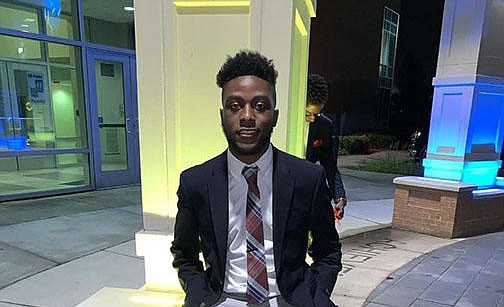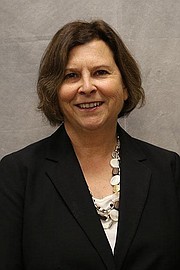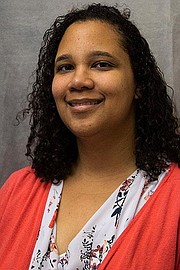FAYETTEVILLE -- No police were called after swastika and "KKK" graffiti appeared in a University of Arkansas, Fayetteville residence hall last fall, said Flo Johnson, UA's top housing official.
But Jordan Farris, 21, said he was told differently by an assistant director in university housing's residence education unit.
Farris began the fall semester as a student resident assistant at Yocum Hall, where the graffiti was found. He described feeling like his concerns were minimized after meeting with full-time housing staffers to raise safety concerns about the graffiti.
"If I'm frank, I think it's abhorrent that they never filed a police report," Farris, who is black, said in an email. "It suggests -- no, it explicitly communicates that housing does not deem the safety of black students to be important. I'm disgusted."
Former UA resident assistants said concerns brought forward on various topics mostly were brushed aside by campus housing department leaders, including about training simulations like role-playing racially charged or discriminatory occurrence.
Some have shared their experiences using the #BlackAtUark hashtag. Hundreds of social media posts by current and former students earlier this month described racially biased or insensitive behavior in many areas of campus life. Black students make up about 4% of all students at UA, or 1,202 students out of the university's total enrollment last fall of 27,559, according to university data.
Chancellor Joe Steinmetz has said UA "will not tolerate actions that violate our commitment to a safe, equitable, inclusive, non-discriminatory and anti-racist campus."
Departments, including university housing, have also issued statements. Housing listed as an action the "continued training of all staff and student leaders on how to respond in the moment and to report expressions of racism and discrimination and racially motivated incidents."
Johnson said a university housing employee with the title of coordinator for residence education made decisions about how to respond to the Yocum Hall graffiti.
The coordinators (CREs), typically have less than five years of full-time experience, said Takama Statton-Brooks, UA's director of residence education. They live on campus and are assigned specific residence halls where they oversee student resident assistants.
"Our protocol is for the CRE to follow up on any type of vandalism and use their professional judgment when the police need to be called," Johnson, UA's assistant vice chancellor for university housing, said in a phone interview Thursday.
While the University of Arkansas Police Department wasn't notified about the Yocum Hall graffiti, "housing notifies UAPD of incidents of vandalism/graffiti that might be hurtful to others in the community," Statton-Brooks, said in a statement. "This practice was reinforced after the September 2019 incident."
GRAFFITI RESPONSE
Farris said he heard from Ben Micek, an assistant director in university housing's residence education unit, that police had been told about the Yocum Hall graffiti.
"He verbally said that he had file[d] a police report," said Farris, who in May earned a bachelor's degree in political science and in African and African American studies.
Farris provided a photo of a computer screen that he said was Micek's that appears to show typed notes of their meeting. The words "police reports have been filed" appear under a heading that lists "KKK" and swastika graffiti. Farris also provided an email from an employee in UA's admissions office stating "the event had been reported to authorities but that this type of report doesn't appear in crime logs."
Micek said he recalled speaking with a resident assistant about the graffiti but couldn't be sure what was said.
"It's very likely that I did say something about that," Micek said, referring to police, adding that while having a conversation with Farris he would "assume" that graffiti of that type "would be reported to police."
UA spokesman Christopher Spencer said the "KKK" graffiti was in a bathroom, while the swastika was on the room door of a residence. They were found on separate occasions in September, he said.
"Housing staff followed up with the residents in that room to notify them of the incident and discuss the situation. The students were unaware that it had happened," Spencer said in an email.
He said housing officials are not aware of any reason to think the graffiti targeted the room residents.
Capt. Gary Crain, a UA police spokesman, said police want to be notified of any graffiti.
"The offense is criminal mischief and, of course, we want to document any cases and try to make sure that it's not repeated or there's a proliferation of it going on," Crain said.
Asked if graffiti like what appeared in Yocum Hall carries more urgency, Crain said that could be the case.
"It depends on the circumstances, but that's why we want to be able to investigate," Crain said.
Spencer said no one was identified as responsible for the graffiti and nothing similar appeared again.
Johnson said the staff did not photograph the graffiti because housekeepers cleaned it up.
This took place despite written instructions for cleaning the staff to notify a building official upon spotting vandalism, Johnson said.
While housekeeping did report the graffiti, "typically our housekeepers would take a picture and send it to the CRE," Johnson said.
Statton-Brooks said there will be a new protocol for bias-related graffiti.
The "standard operating procedure" for UA addressed damage reporting, "but we plan to update it to address incidents of this nature," she said.
Along with police, the new process "will also include reporting to Office of Student Standards and Conduct and the University's Office of Equal Opportunity and Compliance," she said.
ROLE-PLAYING
April Vincent, 20, described the standard training for resident assistants (RAs), called Behind Closed Doors.
The training involves presenting resident assistants with scenarios they might face.
To complete the fall 2019 training, Vincent said she had to respond to classmates role-playing about a racially biased slur being posted to a group chat.
Vincent, an honors college student from Monticello majoring in French and communication, said no one voiced the slur aloud, but there was no consideration for her real-life experience, she said.
"As a black woman, I deal with microagressions and blatant racism on a daily basis. Being asked to relive my trauma as an educational experience for others felt invasive and dehumanizing," Vincent said in an email.
Spencer defended the training while stating that students can opt out.
"Our students are asking for more trainings that help prepare them for potential situations involving racial inequalities and how to engage in civil confrontation when required. It would be irresponsible for us to pretend that our staff won't encounter difficult topics and situations," Spencer said.
Micek said the night before Behind Closed Doors training, students receive descriptive information about scenarios, including if they involve a sexual assault, for example. Students can opt out then or do so during the Behind Closed Doors session, he said.
Vincent disputed that she was told in advance about the scenario "because if I would've known, I would not have participated in that one," she said.
Aidan Link, a 21-year-old chemistry major, said he was a resident assistant for three semesters, including last fall. In an email, he said students receive a schedule in advance, but it "rarely goes into many details, besides a title for an activity." To his knowledge, "they have also never made it clear that you could opt out of the sessions," he said.
Last fall, he found himself in a simulation of a potential suicide.
"A week before this training, one of my childhood friends had committed suicide. During this role-play activity, I started to cry, so I stepped out of the room. When I came back, a CRE (residence hall director-type person) admonished me for 'skipping out on training' and that she would 'inform my supervisor of my actions' in front of the group of my peers," Link said.
TRAINING TOPICS
Behind Closed Doors training is "a practice that is used by many different schools, pretty much every school I can think of," Micek said.
Students get additional training on the covered topics, Statton-Brooks said, with the simulations "kind of at the tail end of a training."
Experts involved with training on sensitive topics, including race, said suddenly taking part in a role-playing scenario can harm someone with that experience in real life.
When it comes to race, "if the intent was to learn how to present a difficult dialogue, that probably does not belong in a Behind Closed Doors training," said Dena Kniess, an associate professor of counselor education and college student affairs at the University of West Georgia.
Kniess said she's familiar with Behind Closed Doors, which she said can be used for certain "safety and security" scenarios.
"If you're going to have a dialogue on race, that needs to be much more intentionally facilitated over time," Kniess said, adding that such a training "can cause psychological harm" by activating an emotional response.
Vincent said: "I started feeling uncomfortable, choked up, and teary-eyed. Eventually, I started crying because the whole situation was very painful."
Elizabeth Self, a Vanderbilt University professor, studies simulations for teachers and said a racially tinged event simulation for a white student "might provide some level of learning."
But "for students who have already heard that aimed at them, it's not something new," Self said.
Vincent said another training exercise involved being assigned a color and then being treated differently while attempting to plan a wedding.
"For example, the red group was harassed by the police," Vincent said, with the assigned colors representing different religions.
"I explained, in front of everyone how problematic the simulation was because it forced people to relive traumatic experiences, be mocked by their peers, and be denied basic human rights," said Vincent, adding that she later gave a presentation on the topic to the housing staff. She said she quit her resident assistant job in February.
Hasan Kwame Jeffries, an Ohio State University history professor, has worked with teachers on avoiding historical simulations that lead to trauma.
"I can share my general rule about simulations, whether about past or the present -- they should neither trivialize the subject matter nor traumatize the subjects (the participants)," Jeffries said in an email. "If they do either then they shouldn't be done."
OBJECTIONABLE VIDEO
Farris said he complained about a video shown during a training on professionalism that featured comedians Kenan Thompson and Nick Cannon in a cross-dressing skit. Students were told, "this is what you don't do behind the desk," Farris said, describing the video as showing a "caricature" of a black woman.
"White students were laughing when that video was being shown. I didn't find it amusing or comical in any way," Farris said.
Vincent also recalled the video.
"It was extremely disrespectful, and it was honestly racist in my opinion," Vincent said.
The video was from the TV show All That and portrayed workers at a convenience store, Spencer said.
"The facilitator showed a portion of the clip and asked questions such as 'what behaviors did you see that may be described as 'unprofessional'?' or 'what opportunities do you see for better customer service?'" Spencer said.
"Though this presentation did not address race or racial stereotypes, one student did approach the presenter following the conversation and shared that it made him feel uncomfortable with the negative portrayal of black women in the clip."
Spencer said the UA housing staff member "apologized to the student and had a dialogue about the impact of this experience." The clip is no longer used.
CONCERNS LINGER
Farris shared an email that he sent to Statton-Brooks dated Oct. 1 outlining his concerns about Yocum Hall.
The email stated: "For the past two weeks, there have been anti-Semitic and racist graffiti in the dorm, including signs of a swastika and the KKK. And to make matters worse, the perpetrators who committed these acts have not been identified. I am writing this email to you because I feel unsafe, vulnerable, and, above all, marginalized."
Statton-Brooks met with him, but he left feeling dissatisfied, Farris said.
"I feel like she was trying to minimize my experience and in some ways was trying to gaslight me to make me believe what I was feeling was just a figment of my imagination," Farris said.
Statton-Brooks, in a statement, said "we strive to make sure students are always comfortable communicating and sharing information with us, especially when there are issues or concerns that need to be addressed."
Farris said student dorm leaders in Yocum Hall were not told about the graffiti until he raised the topic at a dorm staff meeting. He said he learned about the graffiti when told by a full-time staff member, but the staffer did not bring it up at the meeting.
"The black RAs were completely shocked. They were asking him, 'how did we not know about this?' It jeopardizes people of color's safety in the building," Farris said.
Spencer provided copies of two emails addressed to residents on the floors where the graffiti was found.
The emails refer to "racist and hateful" graffiti, without specifying what was found.
"I want to make it clear that we will not tolerate this kind of language and hate towards members of our community," states an email.
Farris said he asked to move. Unhappy with the response to his request, he said he went to the university's top student affairs official, Charles Robinson -- now also UA's interim provost -- and that same day switched residence halls.
"It's important to us that our student employees and all residents feel they can speak about issues that concern them to University Housing staff," Johnson said in a statement. "In this case, I'm glad the student advocated for himself and that he chose to remain employed by Housing even after the event.
Looking forward, we recognize that we can all be more proactive in responding to incidents like this that make our students feel singled out or victimized."


